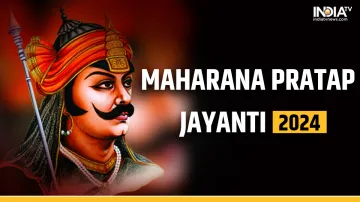Maharana Pratap Jayanti 2024: 10 lesser-known facts about the Rajput King
Explore the legacy of Maharana Pratap on his Jayanti with 10 intriguing facts about the courageous Rajput king. Uncover lesser-known facets of his life and reign in this insightful tribute.

Maharana Pratap Singh, the epitome of courage and resilience, continues to inspire generations with his indomitable spirit and unwavering commitment to his people. While his legendary exploits are well-documented, there exist intriguing details that often escape the limelight. As we celebrate Maharana Pratap Jayanti 2024 on May 9, it's an opportune moment to delve beyond the familiar tales and uncover lesser-known facets of the valorous Rajput king. Here are 10 lesser-known facts about Maharana Pratap that shed light on the remarkable legacy of this iconic figure.
- Birth and Lineage: Maharana Pratap was born on May 9, 1540, in Kumbhalgarh, Rajasthan, as the eldest son of Maharana Udai Singh II, the founder of Udaipur. His birth name was Pratap Singh, and he belonged to the Sisodia clan of Rajputs.
- Early Life and Education: Pratap received rigorous training in martial arts, horse riding, and weaponry from a young age. His education focused on military tactics and governance, preparing him for the responsibilities of rulership.
- Strategic Alliances: Maharana Pratap forged alliances with other Rajput rulers and tribal chiefs to resist Mughal expansion in the region. He maintained a network of alliances with like-minded rulers such as Raja Man Singh of Amer and Rao Chanda of Marwar.
- Battle of Haldighati: The Battle of Haldighati in 1576 is one of the most famous confrontations in Indian history, where Maharana Pratap faced the Mughal forces led by Emperor Akbar's trusted general, Raja Man Singh. Despite being outnumbered and outgunned, Pratap's forces displayed remarkable resilience and valour.
- Guerilla Warfare Tactics: When confronted with superior Mughal forces, Maharana Pratap employed guerilla warfare tactics, utilising the rugged terrain of the Aravalli hills to his advantage. His guerrilla tactics and hit-and-run warfare kept the Mughals on their toes and prevented them from consolidating their control.
- Exile and Struggle: Following the loss at Haldighati, Maharana Pratap and his loyal followers retreated to the hills and forests of the Aravalli range, where they continued their resistance against the Mughals. For years, Pratap lived a life of exile, facing numerous hardships but never compromising on his principles.
- Chetak - The Loyal Steed: Chetak, Maharana Pratap's legendary horse, is renowned for its loyalty and valour. During the Battle of Haldighati, Chetak carried Pratap to safety despite being severely wounded, ensuring his master's escape at the cost of his own life.
- Legacy of Chittor: Chittorgarh, the historic capital of the Mewar kingdom, holds a special place in the legacy of Maharana Pratap. Despite losing the fort to the Mughals, his refusal to surrender and his subsequent struggle symbolise the indomitable spirit of resistance against tyranny.
- Religious Tolerance: Maharana Pratap was known for his respect for all religions. He ensured the protection and freedom of worship for people of all faiths within his kingdom, fostering a culture of religious tolerance and harmony.
- Death and Enduring Legacy: Maharana Pratap breathed his last on January 29, 1597, after years of relentless struggle against the Mughal forces. His legacy of courage, resilience, and unwavering commitment to independence and sovereignty continues to inspire generations of Indians.
On this Maharana Pratap Jayanti 2024, let us remember his acts of bravery and strive to emulate his virtues of courage, integrity, and dedication to the motherland. In an era marked by turbulence and change, the legacy of Maharana Pratap serves as a beacon of hope and inspiration for all who cherish freedom and justice.
ALSO READ: When is Akshaya Tritiya 2024? Know date, puja muhurat, rituals and more